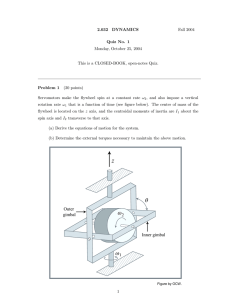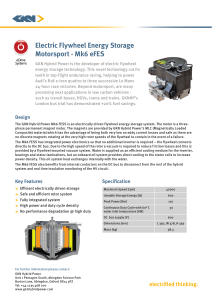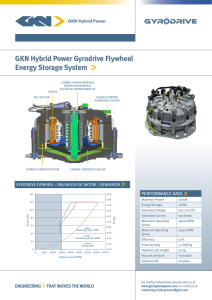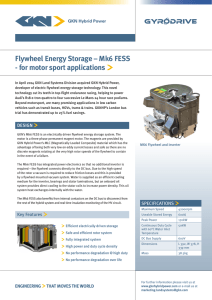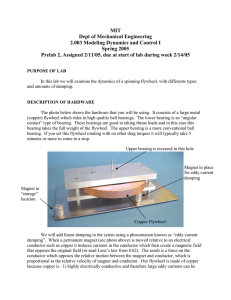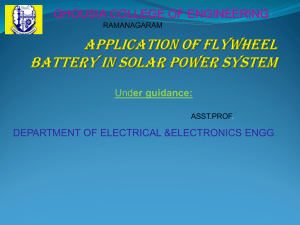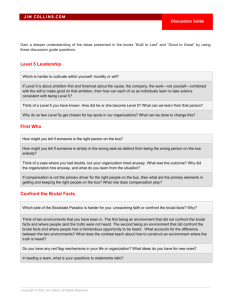ENERGY CONSERVATION WITH FLYWHEELS
advertisement
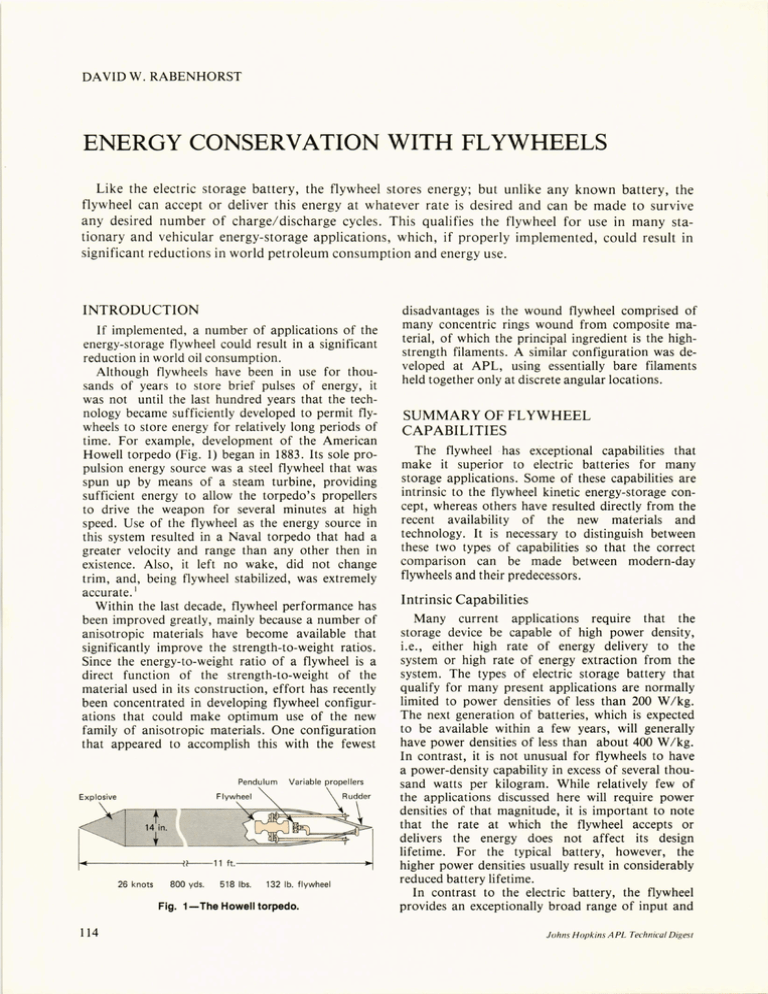
DAVID W. RABENHORST ENERGY CONSERVATION WITH FLYWHEELS Like the electric storage battery, the flywheel stores energy; but unlike any known battery, the flywheel can accept or deliver this energy at whatever rate is desired and can be made to survive any desired number of charge/ discharge cycles. This qualifies the flywheel for use in many stationary and vehicular energy-storage applications, which, if properly implemented, could result in significant reductions in world petroleum consumption and energy use. INTRODUCTION If implemented, a number of applications of the energy-storage flywheel could result in a significant reduction in world oil consumption. Although flywheels have been in use for thousands of years to store brief pulses of energy, it was not until the last hundred years that the technology became sufficiently developed to permit flywheels to store energy for relatively long periods of time. For example, development of the American Howell torpedo (Fig. 1) began in 1883. Its sole propulsion energy source was a steel flywheel that was spun up by means of a steam turbine, providing sufficient energy to allow the torpedo's propellers to drive the weapon for several minutes at high speed. Use of the flywheel as the energy source in this system resulted in a Naval torpedo that had a greater velocity and range than any other then in existence. Also, it left no wake, did not change trim, and, being flywheel stabilized, was extremely accurate. I Within the last decade, flywheel performance has been improved greatly, mainly because a number of anisotropic materials have become available that significantly improve the strength-to-weight ratios. Since the energy-to-weight ratio of a flywheel is a direct function of the strength-to-weight of the material used in its construction, effort has recently been concentrated in developing flywheel configurations that could make optimum use of the new family of anisotropic materials. One configuration that appeared to accomplish this with the fewest Pendulum ~~I14~ ~n I_F~ IYWheel~~ 1 f - - - - - -- .f - o _ II _ _ _ _ _ _ _ 26 k nots -Jn-----11 800 yds. ft . --------~ 518 Ibs. 132 lb. flywheel Fig. 1-The Howell torpedo. 114 disadvantages is the wound flywheel comprised of many concentric rings wound from composite material, of which the principal ingredient is the highstrength filaments. A similar configuration was developed at APL, using essentially bare filaments held together only at discrete angular locations. SUMMARY OF FLYWHEEL CAP ABILITIES The flywheel · has exceptional capabilities that make it superior to electric batteries for many storage applications. Some of these capabilities are intrinsic to the flywheel kinetic energy-storage concept, whereas others have resulted directly from the recent availability of the new materials and technology. It is necessary to distinguish between these two types of capabilities so that the correct comparison can be made between modern-day flywheels and their predecessors. Intrinsic Capabilities Many current applications require that the storage device be capable of high power density, i. e. , either high rate 0 f energy deli very to the system or high rate of energy extraction from the system. The types of electric storage battery that qualify for many present applications are normally limited to power densities of less than 200 W Ikg. The next generation of batteries, which is expected to be available within a few years, will generally have power densities of less than about 400 W Ikg. In contrast, it is not unusual for flywheels to have a power-density capability in excess of several thousand watts per kilogram. While relatively few of the applications discussed here will require power densities of that magnitude, it is important to note that the rate at which the flywheel accepts or delivers the energy does not affect its design lifetime. For the typical battery, however, the higher power densities usually result in considerably reduced battery lifetime. In contrast to the electric battery, the flywheel provides an exceptionally broad range of input and Johns Hopkins A PL Technical Digesl output flexibility. For example, it can be spun up (charged) either by an electric motor, a hydraulic motor, an internal combustion engine, or an air, steam, or hot-gas turbine. Similar flexibility applies to its output. Their flexibility in size distinguishes both the flywheel and the electric battery from most other types of energy-storage systems such as pumped storage and compressed air. The flywheel's performance is not affected by size, and the applications described vary from hundreds of watt-hours to hundreds of megawatt-hours. Since the operating lifetime of the flywheel is generally determined by its exposure to cyclic stress variations during successive chargel discharge cycles, it is usually practical to limit the maximum stress encountered to the level that permits the design lifetime of the flywheel itself to be comparable to the design lifetime of the overall system. The effect, in many cases, is that the overall lifetime cost of a flywheel energy-storage system is reduced compared with an electric battery storage system, which would generally have to be replaced several times during the lifetime of the overall system. Recently Improved Capabilities As stated previously, new materials having considerably greater strength-to-weight ratios than were previously available have permitted the development of flywheel fabrication techniques that result in greatly improved energy-to-weight and energy-to-volume ratios. Generally speaking, the higher performance materials tend to be more expensive, which tends to make the higher performance flywheels more expensive also. Flywheels made of isotropic materials, such as solid steel, have a theoretical energy-storage capability of about 106 Wh/kg. However, in consideration of practical operational conditions (predominantly safety), the isotropic flywheels are generally limited to about 12 Wh/kg. In contrast, the performance of the improved wound flywheels is in the range of 22 to 80 Wh/kg. Actual laboratory demonstrations have achieved more than double that value and theoretical (not practicably achievable) energy densities using the best known materials appear to be about 550 Wh/kg. ("Theoretical energy densities" usually refers to the calculated performance of an infinitely thin ring of the material in question.) There has been a similar improvement in the energy-to-cost ratio of current flywheels. A program recently concluded at APL demonstrated flywheels made of special, low-cost materials, having moderate strength-to-weight ratios, and having an estimated production cost of $50/kWh. 2 Energy densities for the very-low-cost flywheel program ranged within 22 to 44 Wh/kg, although in many low-cost flywheel applications the weight or size of the flywheel is of little consequence to the system. Volume 1, Number 2, 1980 In addition to the great improvement in performance, there has been a corresponding improvement in efficiency. Improved vacuum systems will allow the modern flywheel to operate with acceptable aerodynamic losses. Magnetic suspension and other new bearing technology will allow flywheels to operate with minimum mechanical losses. New rotating seals, as well as new concepts for eliminating seals, promise further reductions in mechanical losses. Using these technologies, it is expected that future flywheel systems will have total losses not exceeding about 1070 of the total power. For example, a . 2 kWh energy-storage system could have a total loss of 20 W. Actually, in the flywheel system, the total loss will be more a function of the total energy in the flywheel, than of the total power, since it is the energy that determines the mass of the flywheel. Thus, a 2 kWh energystorage system would have a loss of 20 Wh/h. Possibly the greatest single advantage accruing from the use of modern high-strength filamentary materials is in the area of safety. The stress in a flywheel's wound filaments varies as a function of the square of the radius from the center of rotation. It follows that if a wound flywheel had an inside radius equal to half the outside radius, it would be theoretically impossible for the flywheel to fail catastrophically (i.e., all fibers fail simultaneously) because the maximum stress at the outside of the flywheel would be four times the maximum stress on the inside. This .feature has been demonstrated repeatedly at APL in the hundreds of spin tests to destruction of flywheels, where the wound structure would typically remain essentially intact after other parts of the flywheel had failed from other causes. Hence, without the need to design for catastrophic failure, the containment problem of the modern flywheel is greatly simplified, compared with the containment problem of previous isotropic flywheels or even composite disc flywheels. The advantage is clearly illustrated in Fig. 2, which shows two different flywheel containment Fig. 2-Flywheel containment comparison between the APL-developed bare-filament configuration (foreground) and a typical laminated composite-disc flywheel (background). 115 rings used for tests to destruction for two types of flywheel. The ring in the background was totally destroyed by an 11 lb composite disc flywheel, which failed at an energy level of 300 Who The ring in the foreground, which was made from the same material, was used to contain successfully more than 50 failed flywheel s of the wound bare-filament configuration, many of which were at higher energy levels than the composite-disc flywheel. ENERGY CONSERVATION IN VEHICULAR FLYWHEEL SYSTEMS The high power density capability of the modern flywheel uniquel y qualifies it as a load-leveling device in both the electric-motor-powered and the internal-combustion-engine-powered automobile. In either case, the principal advantage accrues from the capability of the flywheel to provide the acceleration and braking capability that will reduce the load peak requirements on the battery or engine. In these hybrid cases, the typical weight of the flywheel can be less than 0.5070 of the vehicle's weight. The battery/ flywheel hybrid uses the energy from the batteries to charge the flywheel over relatively long periods of time, whereas the flywheel can deliver the energy to the wheels at high intermittent power levels via an appropriate transmission arrangement. This hybrid system provides a number of advantages to the electric vehicle equipped with it. Elimination of the energy peaks results in significant improvement in battery life. There are also significant improvements in vehicle range because the lower charge and discharge rates result in improved battery performance. Vehicular acceleration is generally improved because the flywheel can, on demand, deliver energy at higher power levels than the battery. Lifetime cost of the vehicle is improved because minimizing the load peaks on the batteries increases their lifetime and extends the period between battery replacements. One example of the battery/ flywheel hybrid ~lec­ tric car is illustrated in Fig. 3. This vehicle has better acceleration and range performance than conventional electric vehicles because a combined flywheel, electric motor/ generator, and controller system are incorporated in it. The system was built by General Electric, while the vehicle was designed and built by the Chrysler Corp. 3 The performance of an automobile powered by an internal combustion engine is similarly improved by including is a flywheel in the power train. The presence of the flywheel allows the size of the engine to be reduced by a factor of three, without compromising acceleration. Also, since the internal combustion engine has to operate over a wide range of rotational speed and power, it is less efficient than it would be if it were operated at a relatively constant speed and power. The addition of the flywheel in the power train allows this to be accomplished effectively. In the hybrid flywheel! 116 Fig. 3-The DOE/General Electric/Chrysler hybrid electric car with a small flywheel to permit improved battery performance by load-leveling the batteries. engine vehicle, the smaller internal combustion engine is arranged to operate at nearly constant speed and near maximum power levels through a variable transmission that spins up the flywheel. When vehicle acceleration is required, the flywheel delivers the energy to the wheels at a much higher power level via the variable transmission. There have been many experimental flywheel! engine vehicles; generally their success is illustrated by the fact that some major car manufacturers around the world are taking an active interest in the concept. Two companies, Volvo (in Sweden) and Volkswagen (in Germany), have announced tentative plans for production of the flywheel! engine vehicle. Typically, in the United States, flywheel!engine hybrid vehicles demonstrate an improvement in fuel consumption of up to 50% while emissions are reduced significantly. Part of the improvement in the fuel economy results from the regenerative braking permitted by the flywheel in the power train. About 30 years ago in Switzerland, the Oerlikon Co. successfully demonstrated the use of flywheels in the urban bus. The Oerlikon bus was powered solely by flywheel energy storage, using a 3000 lb flywheel driving an electric motor/generator. When operated as a motor, the electrical unit charged the flywheel; during operation of the bus, the electrical unit functioned as a generator, providing power to electric motors in the vehicle's wheels. Having operated successfully for more than 17 years in several countries, the flywheel-powered bus was obviously feasible. I At present there are a number of programs around the world in which the U5e of a flywheel-powered bus is being vigorously pursued. In the United States, a $5M program was recently initiated at General Electric to develop a bus powered solely by a flywheel. This vehicle (Fig. 4) will operate on the same principle as the Oerlikon bus. The principal difference between the current General Electric program and the previous Oerlikon program is that modern flywheels and control components will enable the new bus to go J uhns H opkins A PL Technical Digest Fig.5-Soviet flywheel/engine hybrid bus (circa 1971). Fig. 4-DOE/General bus. Electric flywheel·powered urban the entire length of the bus route on one charge. The Oerlikon bus range was limited to the distance between one or two bus stops. A similar-sized contract was also recently issued to the Garrett Corp. to develop an urban bus with a flywheel! combustion engine. The flywheel! engine vehicle will have a diesel engine of about half the size normally used; the vehicle is expected to demonstrate a fuel saving of 50070 compared with the conventional diesel bus. Programs for flywheel-powered urban buses are also being pursued in other countries. In Italy, the development of the flywheel propulsion system for the urban bus has been under way for several years. The Italian urban-bus flywheel, with a capacity of 2.5kWh, is under life-cycle testing presently. This flywheel is fabricated from steel wire using the bare-filament technology developed atAPL. In West Germany, a more advanced flywheel! diesel bus is expected to be demonstrated soon. Other study programs for flywheel-powered urban buses are under way in the Netherlands, Sweden, USSR, Japan, and Canada. The principal reason for this extensive worldwide activity is the promise of greatly improved fuel economy. However, the Soviets claim an additional advantage for their flywheel! engine hybrid bus (Fig. 5)-that the maintenance and lifetime of the vehicle's braking system is greatly improved by using regenerative braking in the flywheel system. 4 The U.S. Department of Energy, in conjunction with the Metropolitan Transit Authority of New York City, recently concluded a demonstration program in that city in which the operational energy of a subway train was improved more than 30% by using on-board flywheel energy-storage systems, which allowed much of the kinetic energy from deceleration of the train to be recovered in the Volume I , Number 2,1980 flywheel system for subsequent use in acceleration. 5 The flywheel is also being considered for improving the performance of the conventional electric train. Programs are under way in West Germany, as well as in the United States, to study the feasibility of wayside charging stations, based on the use of flywheel energy storage. In this application, energy is recovered from a train going down a mountain and stored in the flywheel for subsequent use in the next train going up the mountain. Studies have shown that the energy savings in this application can be considerable. ENERGY CONSERVATION IN STATIONARY FLYWHEEL SYSTEMS In the United States and many other countries, the typical load versus time curve for the utility company indicates a diurnal load variation having minimum-to-maximum load peaks greater than 50% of the total load. The most efficient generating plants are those that can operate constantly over a 24 h period. In the United States, older fossil-fuel-fired generating plants are used for the intermediate portion of the load cycle because they can be turned on and off each day, as required, without a substantial penalty in efficiency. There are also sharp peaks in the load each day that amount to nearly 25% of the installed power capacity but that represent only about 4% of the total daily energy requirement. These power peaks are usually provided by fossil-fuel-fired turbine units whose fuel · consumption is considerably higher (and more expensive) than that of the baseload and intermediate-load generating plants. The basic premise regarding the use of energy storage as an energy conservation device is that it can permit many of these less efficient powerpeaking plants to be eliminated, thereby reducing the national petroleum consumption. Flywheel energy-storage systems would allow the excess energy stored during off-peak hours to be delivered to the load during the peak cycle. 6 Studies have shown that energy storage at the load site and at the utility site are both effective. In the United States a typical example is the individual home. Programs are under way to demonstrate the feasibility of using flywheel energy storage in the 117 home at night to reduce the diurnal load peaks on the utility system. APL has recently completed a program for the Department of Energy, aimed primarily at demonstrating the feasibility of lowcost flywheels for the individual home. The principal objectives of the APL program were to develop a flywheel configuration that allows the use of inexpensive materials, to develop bearing systems having low losses and potentially long life, and to demonstrate these components in a complete energy-storage system. The final flywheel developed during the program (Fig. 6) is wound from conventional steel-belted tire wire on a fiberglass intermediate hub, to which is bolted an aluminum attach fixture. The estimated production cost for a flywheel of this type is approximately $50/kWh, which is much less than the cost of other flywheels. APt's approach to the low-loss bearing was to use conventional rolling contact bearings in configurations that minimize bearing loads and rotational speeds. One configuration tested successfully (Fig. 7) has two bearings arranged geometrically so that they function as though one bearing were located inside the other. Each bearing operates at half the normal rotational speed with corresponding reduction in losses and increase in lifetime. Bearing loads were minimized in the APL system by installing the flywheel on a vertical, flexible shaft. By means of this thin shaft, the lateral loads on the bearings (normally caused by flywheel imbalance) were reduced to negligible values. Also, the vertical gravity loads were greatly reduced by using a passive magnet load-relief system that was adjusted to carry about 95070 of the total rotating mass. This system consisted of a stationary ceramic magnet (similar to that used in a loudspeaker) attracting a permeable "r otating pole piece attached to the flywheel shaft. The degree of improvement in bearing losses through the use of the APL-developed bearing techniques is illustrated in Table 1; The flywheel and bearings were incorporated into a complete energy-storage system to demonstrate the feasibility Fig. 6-The APL·developed low·cost bare·filament fly· wheel. Rotating shaft Fig. 7- The series bearing concept for reducing bearing rotational speed and improving bearing life. Table 1 COMPARISON OF BEARING PERFORMANCE Parameter Bearing Type Conventional Flywheel rotating weight (Ib) Bearing type Bearing bore (mm) Bearing losses ( W) @ 10,000 rpm Loss comparison (%) Plain, Unloaded 85 Series, Unloaded 85 Slow Roller, Unloaded * 85 100H 10 100H 10 36H 25 1.4 0.74 6 ::=0.30 100 5.6 3.0 ::=1 97 206H 30 ·Characteristics of the slow roller bearing are estimated from the known relationships of the smaller bearings and lower rotational speeds; all others are actual measurements. 118 Johns Hopkins A PL Technical Diges t of ffywheel storage for home use. The system is designed to accept conventional single-phase, 115V, 60-Hz power (from a conventional wall socket), convert it to three-phase, variable-frequency power, and apply it to an electric induction motor. The induction motor, which is contiguous to the flywheel shaft, spins up the flywheel to its design rotational speed (14,300 rpm). The electronic controls then cause the motor to operate as an electric generator which, being driven by the flywheel, produces electrical power that is reconverted to steady-state 115 V at 60 Hz. This flywheel-stored power has been used successfully to run typical household appliances. A program is under way at the Massachusetts Institute of Technology for a scale demonstration of a complete, full-sized, energy-storage system for the home, involving a several-thousand-pound flywheel and a special control system. The system would automatically accept energy from the utility company during the night, store it, and then provide the total energy requirements of a home during the day, thus completely eliminating that home's contribution to the utility peaking cycle. 7 Studies have shown that industrial plants cont~ibuting to the diurnal peaking problem can also use flywheel energy-storage systems to reduce peak load requirements. A side benefit from the home and industry diurnal storage systems is that, at present, in many locations in the United States, nighttime energy is available at a fraction of the cost of daytime energy. Other studies in many countries have shown that energy storage at the utility site is equally effective in eliminating the need for diurnal peaking plants and in greatly reducing the petroleum requirements of the utility companies. Although these energystorage systems may eventually be large enough for 160 MWh of storage capacity, this capacity need not be provided by a single flywheel. For example, in a recently completed study at APL, it was concluded that 1400 small, mass-produced, flywheel generator systems could be installed in underground silos in a land area of about half an acre. The general arrangement of the multi flywheel array is illustrated in Fig. 8. The recent study indicated that, while the total cost of such a system would be slightly higher than the cost of one using a few large flywheels, the technology required for the smaller flywheel system already exists, whereas development of the technology required for the larger flywheels may take several years. CONCLUSIONS The principal conclusions that can be drawn from these developments are: 1. The modern flywheel has capabilities that uniquely qualify it for a number of energy conservation concepts. Volume 1, Number 2,1980 7 ft dia. service area *C J 2' 1'--16'===:-1 ~~at;;;:::center of Si-..-IO__ C ) ~ Coolant and electrical connections 48' Five flywheels per floor 8 floors per silo 4.54 MWh per silo I Total flywheel array: 1440 flywheels 160 MWh 100 MW peak Estd cost = $l54/kWh for 3D-year life cycle 36 silos over area of 1/2 acre, including roadways I J ,,/ Fig. 8- Large·scale modular flywheel energy·storage system. 2. 3. The use of flywheels in various transportation applications could reduce fuel consumption and lifetime costs significantly. The widespread use of flywheels in stationary energy systems could reduce the consumption of fuel in power plants by cutting back on the lise of the petroleum-consuming equipment that would otherwise be required to accommodate the diurnal load peaks; it would also greatly enhance the energy production capability of these power plants by allowing them to operate continuously at conditions of maximum design load. REFERENCES lR. C. Clerk, "The Utilization of Flywheel Energy," ASME Paper No. 711A (1963). 2D. W. Rabenhorst, T. R. Small, and W . o. Wilkinson , " Final Report, Low-Cost Flywheel Demonstration Program (I October 1977- 31 December 1979)," U.S. Department of Energy Report DOE/ EC / I-5085 (1980). 3"Electric and Hybrid Vehicle Program ," 3rd Annual Report to Congress for FY 1979, U.S. Department of Energy Report DOE/ CS-0130 (1980) . 4N. V. Gulia, Inertial Energy Accumulators, Voronezh Uni versity Press, USSR, (1973) . 5D. Raskin, "Energy Storage Propulsion System for Rapid Transit Cars : Test Results and System Evaluation," UMTA-NY -06-0006-78-1, Final Report, Metropolitan Transportation Authority, New York City (1979) . 6 Westinghouse Eng, 31, No. I, (1971). 7A. R. Millner, " A Flywheel Energy Storage and Conversion System for 'Photovoltaic Applications," International Assembly on Energy Storage, Dubrovnik , Yugoslavia (1979) . 119
